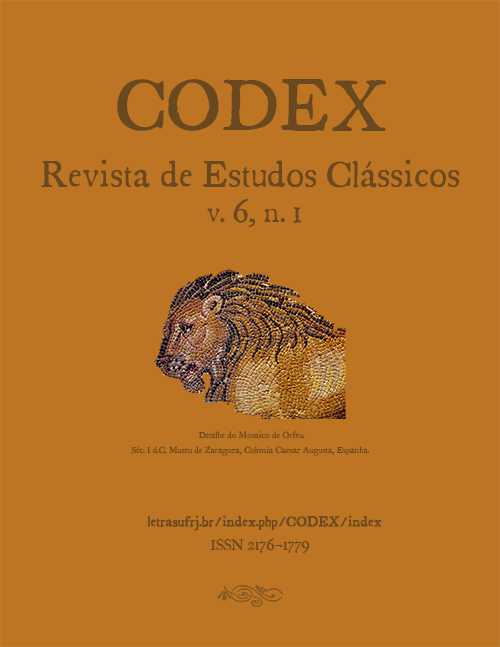L'inganno sonoro. Brevi considerazioni sulla “ventriloquia” nel periodo tardo latino e medievale
DOI:
https://doi.org/10.25187/codex.v6i1.14914Palavras-chave:
engastrimuthos, ventriloqui, Caroli Magni Capitulare de imaginibus, periodo tardo latino e medievaleResumo
Partendo dalla descrizione degli Engastrimythes contenuta in un passo del quarto libro delle “Avventure di Pantagruele” di F. Rebelais (1552) e riallacciandosi ai recenti studi in ambito greco, l'articolo propone una breve indagine sulla “ventriloquia” nel periodo tardo latino e medievale, mostrando evoluzioni semantiche e specializzazioni del termine e concentrando poi l'interesse sullo spartiacque critico fornito (da un capitolo) dal Caroli Magni Capitulare de imaginibus sino a giungere alle soglie del Cinquecento.
Downloads
Referências
BRACCINI, T. “Peripherein ton daimona: la voce del ventriloquo”, In: Prestare la voce - I quaderni del ramo d'oro on-line, VI, (2013/2014), pp. 21-33.
BRUNET, E. “Le icone acheropite a Nicea II e nei Libri Carolini”, In: CASTAGNO, A. Monaci (a cura di). Sacre impronte e oggetti «non fatti da mano d'uomo» nelle religioni. Atti del Convegno Internazionale di Torino. 18-20 maggio 2010, Alessandria 2011, pp. 201-231.
CHÉRON, P. (Éd.). Les cinq livres de F. Rabelais (avec des variantes et un glossaire), ornés de 11 eaux-fortes par E. Boilvin. Paris, Librairie des Bibliophiles, 1876.
COCKTON, H. The life and adventures of Valentine Vox, the Ventriloquist. London, Willoughby and Co., 1840.
CONNOR, S. Dumbstruck: a cultural history of ventriloquism. Oxford; New York, Oxford University Press, 2000.
DAVIES, H. Gender and ventriloquism in Victorian and Neo-Victorian fiction: passionate puppets. Basingstoke; New York, AIAA, 2012.
DAVIS-WEYER, C. (Ed.). Early Medieval art 300-1150: sources and documents. Toronto, University of Toronto Press, 1986.
DE LA CHAPELLE, J.-B. Le ventriloque, ou l'engastrimythe. London, Abbé de la Chapelle, 1772.
DI DOMENICO, P. G.; VALENZIANO, C. Atti del Concilio Niceno Secondo Ecumenico Settimo, I. Città del Vaticano, Libreria Editrice Vaticana, 2004.
DODDS, E. R. I greci e l'irrazionale (Trad. it.). Milano, Rizzoli, 2009.
DU TILLET, J. Opus illustrissimi et excellentissimi seu spectabilis. viri Caroli Magni nutu Dei, Regis Francorum, Gallias, Germaniam, Iraliamque, sive harum finitimas provincias domino opilante regentis, contra synodum, quae in partibus Greaeciae pro adorandis imaginibus gesta est. Paris, 1549.
ERDMAN, D. V. (Ed.). “S. T. Coleridge. Essays on his times in the Morning Post and the Courier”, In: COBURN, K. (Gen. Ed.). The collected works of Samuel Taylor Coleridge. III. London; Princeton, Routledge & Kegan Paul, 1978.
FREEMAN, A. “The marginal notes in Vaticanus latinus 7207”, In: Speculum 46 (1971), pp. 597-612.
FREEMAN, A.; MEYVAERT, P. Opus Caroli regis contra synodum (Libri Carolini). Hannover, Leipzig, 1998 (= Monumenta Germaniae Historica, Concilia, Bd. 2, Supplementum I).
HAENDLER, G. Die Libri Carolini, ein Dokument der fränkischen Fr¶mmigkeitsgeschichte. Greifswald, Hohen Theologischen Fakultät der Greifswald Universität, 1950.
HAYES, M. Divine ventriloquism in Medieval English literature: power, anxiety, subversion. New York, Palgrave Macmillan, 2011.
HODGSON, J. A. “An other voice: ventriloquism in the Romantic period”, In: Romanticism on the Net, XVI, november 1999, pp. 0-0. DOI: 10.7202/005878ar.
KRAUSE, V. “Idle works in Rabelais's Quart livre: the case of the Gastrolatres”, In: Sixteenth Century Journal: The Journal of Early-Modern Studies 30, I (1999), pp. 47-60.
LAMBERZ, E. (A cura di). Concilii Actiones VI-VII. Berlin; Boston, De Gruyter, 2016.
LELLI, E. (A cura di). Erasmo da Rotterdam. Adagi. Milano, Bompiani, 2013.
MITALAITÉ, K. Philosophie et théologie de l'image dans les Libri Carolini. Paris, Institut d'Études Augustiniennes, 2007, pp. 455-468.
MORRIS, B. “Demonic ventriloquism and Venetian skepticism in Othello”, In: SEL - Studies in English literature 1500-1900, 53, 2, (2013), pp. 311-335.
NOBLE, T. F. X. Images, iconoclasm, and the Carolingians. Philadelphia, University of Pennsylvania Press, 2009.
OMMUNDSEN, A. “The Liberal arts and the polemical strategy of the Opus Caroli regis contra Synodum (Libri Carolini)”, In: Symbolae Osloensis 77 (2002), pp. 175-200.
PASSINI, G. Gargantua e Pantagruele di F. Rabelais. Roma, Newton Compton, 1925.
RABELAIS, F. La vie de Gargantua et de Pantagruel (Quart Livre). Paris, 1552.
___________. La vie de Gargantua et de Pantagruel I-V. Paris, 1532-1564.
SAHAS D. J. Icon and logos: sources in Eighth-century iconoclasm: an annotated translation of the sixth session of the seventh Ecumenical Council (Nicea, 787). Toronto, University of Toronto Press, 1986.
SCHMANDT, W. Studien zu den Libri Carolini. Mainz, Sitters burodienst, 1966.
SPECK, P. Die Interpolationen in den Akten des Konzils von 787 und die Libri Carolini. Bonn, Habelt, 1998.
WALLACH, L. Diplomatic studies in Latin and Greek documents from the Carolingian age. London, Cornell University Press, 1977.
Downloads
Arquivos adicionais
Publicado
Como Citar
Edição
Seção
Licença
A Codex - Revista de Estudos Clássicos utiliza uma licença Creative Commons - Atribuição-NãoComercial 4.0 Internacional.
Os autores dos trabalhos aprovados autorizam a revista a, após a publicação, ceder seu conteúdo para reprodução em indexadores de conteúdo, bibliotecas virtuais e similares.
A revista se permite o uso dos trabalhos publicados para fins não comerciais, incluindo o direito de enviar o trabalho para bases de dados de acesso público.










